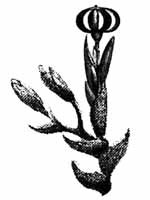Introduction to the Andreaeopsida
the lantern mosses
 The lantern mosses (Andreaeopsida) are a basal group of mosses commonly found growing on exposed rock surfaces.
They are able to cling to the rocks by their multicellular rhizoids,
which delve into tiny cracks on the rock surface and anchor the plant.
As in most mosses, the leaves of the latern mosses usually have a costa,
or multilayered central supporting strand, though some species do not. The
rest of the leaf is a single layer of cells, so that every cell is in close
contact with the environment.
The lantern mosses (Andreaeopsida) are a basal group of mosses commonly found growing on exposed rock surfaces.
They are able to cling to the rocks by their multicellular rhizoids,
which delve into tiny cracks on the rock surface and anchor the plant.
As in most mosses, the leaves of the latern mosses usually have a costa,
or multilayered central supporting strand, though some species do not. The
rest of the leaf is a single layer of cells, so that every cell is in close
contact with the environment.
Mature latern mosses grow as clumps of small reddish to blackish brown plants.
The dark pigments are located in the cell walls, and may help to reduce
light damage caused by exposure in their rocky habitats -- most mosses require
lower light levels for successful photosynthesis than other plants.
The mosses are able to survive desiccation for long periods, and may recover
even after being completely dried out. Such dessication would kill most
other kinds of plants.
There are about 100 species of lantern moss, classified in two genera.
The genus Andreaea includes all but one of these species,
Andreaeobryum macrosporum (of Alaska and northwestern Canada). An
additional genus Neuroloma (of Tierra del Fuego and South Georgia) has
been renamed as a species of Andreaea.
Most species grow in cool temperate to polar regions, and the
majority are found in the Southern Hemisphere. They commonly are found
growing in high, sunny alpine regions even in the tropics, though some other
species prefer damp habitats. The preference of lantern mosses for rocky and
alpine habiatats may explain why this apparently ancient group has left
no fossil record.
Andreaeopsida have two distinctive features that separate them from other
groups of mosses. First, the protonemata have a different structure.
Protonemata are the earliest stage in growth
of a moss from the spore, and in most mosses they grow as a network of
filaments. In the Andreaeopsida, however, the protonemata are thallose,
forming a multicellular flattened layer of embryonic cells.
In addition to protonemata differences, lantern mosses also release their
spores differently. Most mosses produce a stalked capsule whose top falls off
to release the spores, and a ring of flexible teeth around the opening to
regulate spore release. The capsules of lantern mosses have no stalk, no cap,
and no teeth. Instead, the capsule is elevated on an extension of the plant
to which it is attached. This gametophytic extension is called a pseudopodium, or "false foot", and it pushes the capsule upwards so that spores may
be dispersed further. The capsule itself opens by splitting lengthwise in
four slits (sometimes 8), as you can see in the illustration above. The
four partitions of the capsule wall between the slits bow outwards, expanding
the slits and releasing the spores. A short columella ("little column")
in the center of the capsule keeps the capsule wall from collapsing too far.

Composite illustration of Andreaea Hartmanii after Trotter.
Sources:
- Akira Noguchi. 1987. Illustrated Moss Flora of Japan, Part I. Hattori Botanical Laboratory.
- Ryszard Ochyra. 1998. The Moss Flora of King George Island, Antarctica. Cracow: Polish Academy of Sciences.
- W. B. Schofield. 1985. Introduction to Bryology. New York: Macmillan Publishing Company.
- L. B. C. Trotter. 1948. Andreaea Hartmanii Thed. -- A histological study. Transactions of the British Bryological Society 1(2):101-103, 2 plates.


 The lantern mosses (Andreaeopsida) are a basal group of mosses commonly found growing on exposed rock surfaces.
They are able to cling to the rocks by their multicellular rhizoids,
which delve into tiny cracks on the rock surface and anchor the plant.
As in most mosses, the leaves of the latern mosses usually have a costa,
or multilayered central supporting strand, though some species do not. The
rest of the leaf is a single layer of cells, so that every cell is in close
contact with the environment.
The lantern mosses (Andreaeopsida) are a basal group of mosses commonly found growing on exposed rock surfaces.
They are able to cling to the rocks by their multicellular rhizoids,
which delve into tiny cracks on the rock surface and anchor the plant.
As in most mosses, the leaves of the latern mosses usually have a costa,
or multilayered central supporting strand, though some species do not. The
rest of the leaf is a single layer of cells, so that every cell is in close
contact with the environment.


